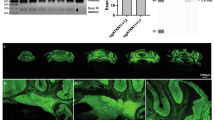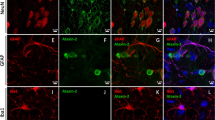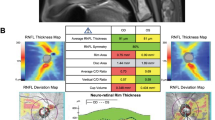Abstract
Spinocerebellar ataxia type 10 (SCA10; MIM 603516; refs 1,2) is an autosomal dominant disorder characterized by cerebellar ataxia and seizures. The gene SCA10 maps to a 3.8-cM interval on human chromosome 22q13–qter (refs 1,2). Because several other SCA subtypes show trinucleotide repeat expansions, we examined microsatellites in this region. We found an expansion of a pentanucleotide (ATTCT) repeat in intron 9 of SCA10 in all patients in five Mexican SCA10 families. There was an inverse correlation between the expansion size, up to 22.5 kb larger than the normal allele, and the age of onset (r2=0.34, P=0.018). Analysis of 562 chromosomes from unaffected individuals of various ethnic origins (including 242 chromosomes from Mexican persons) showed a range of 10 to 22 ATTCT repeats with no evidence of expansions. Our data indicate that the new SCA10 intronic ATTCT pentanucleotide repeat in SCA10 patients is unstable and represents the largest microsatellite expansion found so far in the human genome.
This is a preview of subscription content, access via your institution
Access options
Subscribe to this journal
Receive 12 print issues and online access
$259.00 per year
only $21.58 per issue
Buy this article
- Purchase on SpringerLink
- Instant access to full article PDF
Prices may be subject to local taxes which are calculated during checkout





Similar content being viewed by others
References
Matsuura, T. et al. Mapping of the gene for a novel spinocerebellar ataxia with pure cerebellar signs and epilepsy. Ann. Neurol. 45, 407–411 (1999).
Zu, L., Figueroa, K.P., Grewal, R. & Pulst, S.M. Mapping of a new autosomal dominant spinocerebellar ataxia to chromosome 22. Am. J. Hum. Genet. 64, 594–599 (1999).
Orr, H.T. et al. Expansion of an unstable trinucleotide CAG repeat in spinocerebellar ataxia type 1. Nature Genet. 4, 221–226 (1993).
Pulst, S.M. et al. Moderate expansion of a normally biallelic trinucleotide repeat in spinocerebellar ataxia type 2. Nature Genet. 14, 269–276 (1996).
Sanpei, K. et al. Identification of the spinocerebellar ataxia type 2 gene using a direct identification of repeat expansion and cloning technique, DIRECT. Nature Genet. 14, 277–284 (1996).
Imbert, G. et al. Cloning of the gene for spinocerebellar ataxia 2 reveals a locus with high sensitivity to expanded CAG/glutamine repeats. Nature Genet. 14, 285–291 (1996).
Kawaguchi, Y. et al. CAG expansions in a novel gene for Machado-Joseph disease at chromosome 14q32.1. Nature Genet. 8, 221–228 (1994).
David, G. et al. Cloning of the SCA7 gene reveals a highly unstable CAG repeat expansion. Nature Genet. 17, 65–70 (1997).
Zhuchenko, O. et al. Autosomal dominant cerebellar ataxia (SCA6) associated with small polyglutamine expansions in the α 1A-voltage-dependent calcium channel. Nature Genet. 15, 62–69 (1997).
Holmes, S.E. et al. Expansion of a novel CAG trinucleotide repeat in the 5′ region of P2R2B is associated with SCA12. Nature Genet. 23, 391–392 (1999).
Koob, M.D. et al. An untranslated CTG expansion causes a novel form of spinocerebellar ataxia (SCA8). Nature Genet. 21, 379–384 (1999).
Matsuura, T., Watase, K., Nagamitsu, S., Zoghbi, H.Y. & Ashizawa, T. Fine mapping of the spinocerebellar ataxia type 10 region and search for a polyglutamine expansion. Ann. Neurol. 46, 480 (1999).
Dunham, I. et al. The DNA sequence of human chromosome 22. Nature 402, 489–495 (1999).
Schalling, M., Hudson, T.J., Buetow, K.H. & Housman, D.E. Direct detection of novel expanded trinucleotide repeats in the human genome. Nature Genet. 4, 135–139 (1993).
Trottier, Y. et al. Polyglutamine expansion as a pathological epitope in Huntington's disease and four dominant cerebellar ataxias. Nature 378, 403–406 (1995).
Bidichandani, S.I., Ashizawa, T. & Patel, P.I. The GAA triplet-repeat expansion in Friedreich ataxia interferes with transcription and may be associated with an unusual DNA structure. Am. J. Hum. Genet. 62, 111–121 (1998).
Wells, R.D. & Warren, S.T. Genetic Instability and Hereditary Neurological Diseases (Academic, San Diego, 1998).
Koob, M.D. et al. Rapid cloning of expanded trinucleotide repeat sequences from genomic DNA. Nature Genet. 18, 72–75 (1998).
Ikeuchi, T. et al. A novel long and unstable CAG/CTG trinucleotide repeat on chromosome 17q. Genomics 49, 321–326 (1998).
Breschel, T.S. et al. A novel, heritable, expanding CTG repeat in an intron of the SEF2-1 gene on chromosome 18q21.1. Hum. Mol. Genet. 6, 1855–1863 (1997).
Acknowledgements
We thank the patients for cooperation; L.P.W. Ranum for confirming RED analysis results; and The Sanger Centre for BAC, PAC and cosmid clones located in the chromosome 22 region of interest. This work was supported by grants from the Oxnard Foundation/National Ataxia Foundation (T.A.), National Ataxia Foundation (S.M.P.), Howard Hughes Medical Institute (H.Y.Z.), the National Institute of Health/NICHD HD29256 (D.L.N.), MRRC HD24064, NINDS NS27699 and GCRCM01RR00188 (H.Y.Z.), NS29709 (J.L.N.), NS33123 and NS37883 (S.M.P.), and K12-AG0052-01 (R.P.G.). The fellowship of T.M. was partly supported by the Cell Science Research Foundation, the Yamanouchi Foundation for Research on Metabolic Disorders and the Nakayama Foundation for Human Science, Japan. D.L.B. was supported by an American Epilepsy Society Fellowship.
Author information
Authors and Affiliations
Corresponding author
Rights and permissions
About this article
Cite this article
Matsuura, T., Yamagata, T., Burgess, D. et al. Large expansion of the ATTCT pentanucleotide repeat in spinocerebellar ataxia type 10. Nat Genet 26, 191–194 (2000). https://doi.org/10.1038/79911
Received:
Accepted:
Issue date:
DOI: https://doi.org/10.1038/79911
This article is cited by
-
Consensus Paper: Strengths and Weaknesses of Animal Models of Spinocerebellar Ataxias and Their Clinical Implications
The Cerebellum (2022)
-
Spinocerebellar Ataxia Type 10 with Atypical Clinical Manifestation in Han Chinese
The Cerebellum (2022)
-
Intellectual disability genomics: current state, pitfalls and future challenges
BMC Genomics (2021)
-
Small molecule targeting r(UGGAA)n disrupts RNA foci and alleviates disease phenotype in Drosophila model
Nature Communications (2021)
-
Response to ATXN10 Microsatellite Distribution in a Peruvian Amerindian Population
The Cerebellum (2021)



